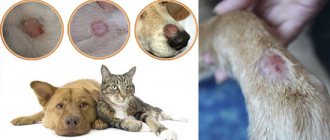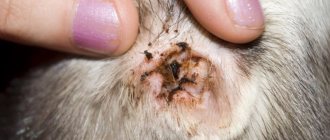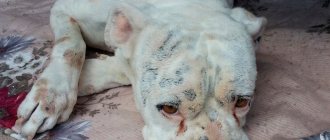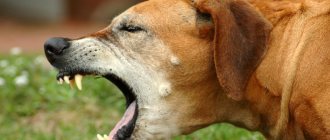Stinging insect bites are dangerous, first of all, because of a rapidly developing allergic reaction. It is impossible to know in advance how serious the body’s response to poison will be, so every owner should know what to do if a dog is bitten by a bee, wasp or hornet, and have the necessary medications in their home veterinary medicine cabinet.
Dogs often like to catch wasps and bees with their teeth.
How dangerous is a bee sting for a dog?
Not all dog owners know how much harm a wasp or bee sting can cause to their pet. In fact, such an incident cannot be ignored: after all, dogs, like people, can become allergic to insect venom. This allergy comes in one of two types:
- congenital (the reaction occurs after the first bite);
- acquired (develops with repeated bites).
Any dog breeder needs to know that a certain percentage of dogs, due to an allergy to bee venom, experience anaphylactic shock, which can lead to swelling of the larynx, and as a result, difficulty breathing and even death of the animal. Especially dangerous are numerous insect bites that occur, for example, when a dog destroys a wasp nest, as well as situations in which the dog was stung in the face, lip or tongue. If this happens, it is recommended to take the dog to the veterinarian as soon as possible.
However, there is no need to panic: although most dogs react painfully to insect bites, this does not cause serious harm to health provided that assistance is provided competently and the pet is closely monitored.
Bee sting: is it dangerous?
When bees bite, they dig into the skin of a domestic animal and leave a sting in it, which contains barbs and a poisonous sac.
If the dog encounters not a bee, but a hornet, bumblebee or wasp, they may also bite. Dog and bee
Note! Bees don't bite, they sting. They can do this only once, after which they die, leaving a sting in the enemy’s body with part of their intestines.
After a bee sting, the animal's paws and nose usually swell. But in addition, other troubles may develop:
- Anaphylactic shock is a consequence of an allergic reaction to an insect bite. Main symptoms: blisters form on the skin, severe swelling of the tissues and skin, wheezing is heard during breathing, possible vomiting, convulsions, involuntary bowel movements and gall bladder, and a plaintive whining.
- Suffocation. It’s not so scary if the dog is stung by an insect, for example, on the paw. It is much worse if a honey insect flew into the mouth of a curious pet. In most cases, the dog's oxygen supply is blocked, so assistance must be provided immediately.
- An allergic reaction develops mainly only if the dog is bitten by several bees at the same time or with a slight difference in time. Against this background, the following symptoms may develop: severe itching and swelling at the site of the bite, upset of the digestive tract, and fever.
Slight swelling and a single squeal are a normal reaction and there is no cause for concern. If more severe symptoms develop, you must take your dog to the hospital immediately, otherwise it can lead to death.
Bite symptoms
How can you tell if your dog has been bitten in order to take timely action? If this did not happen before your eyes, pay attention to the following signs:
- if a bee bites a dog on the paw, the dog whines, gnaws or licks its claws and fingertips - this is caused by pain and itching at the site of the bite;
- if the muzzle is injured, the dog may howl, whine, and rub the bitten area with its paws.
Swelling, lethargy, increased salivation, and difficulty breathing may also occur.
How to tell if your dog has been bitten
Allergies can be congenital or acquired. The difference is in the time of manifestation of symptoms: congenital symptoms appear immediately, acquired symptoms appear after some time.
First signs of a bite
- squealing, plaintive and prolonged whining;
- the dog jumps away from some place or, conversely, rushes at it barking;
- can run away somewhere and hide;
- in rare cases, there is immediate sudden lethargy, the dog falls to the ground and breathes heavily.
What other symptoms might there be?
- if the bite is in the muzzle area, then visible swelling and painful swelling usually appear;
- severe inhibition in behavior, the dog seems to go limp, becomes lethargic and practically does not react to what is happening around; obvious lameness and swelling of the limb if the bite was on the paw;
- if the bite is in the mouth, the tongue, cheeks, and palate will swell inside, the mouth is open all the time, the dog will whine, saliva will flow copiously;
- mucous membranes become almost white, sometimes with a bluish tint (attention is drawn to the inner surface of the cheeks, conjunctiva and whites of the eyes, gums);
- when the sting penetrates shallowly into the skin, a local allergic reaction appears: itching, redness, urticaria, slight local swelling, increased skin temperature at the wound site;
- breathing becomes difficult, wheezing appears (these signs develop very quickly if the dog is bitten in the face by a wasp);
- vomiting is very rare;
- rapid heartbeat, but with weak vascular filling (thread-like pulse);
- feverish trembling, sudden short-term jumps in body temperature;
- involuntary urination;
- disorientation in space, unsteadiness of gait;
- convulsions and loss of consciousness.
The worst danger from bites is anaphylactic shock. In such a situation, you need to save the dog as soon as possible. The difficulty is that anaphylaxis develops at different speeds: with rapid development, you may not have time to help, with slow development, they do not always think of an allergy, and therapy is directed in the wrong direction. With such symptoms, the dog should be taken to the clinic immediately!
First aid
In the event of a bite, behave calmly, do not panic or scold the dog under any circumstances: after all, the dog is already stressed from pain and surprise. Take the following actions as soon as possible:
- Pull out the sting if there is one.
Insects sting in different ways: for example, a sting remains at the site of a bee sting; wasps, bumblebees and hornets do not leave it. Therefore, if a dog is bitten by a bee, the sting must be removed immediately. This can be done using tweezers, nails, nail scissors, or a handy tool such as a plastic card. There is a sac with poison on the bee sting, so it must be pulled out carefully, using sliding movements, so that the remaining toxic substance is not squeezed out and does not enter the animal’s blood. - Treat the stung area.
Apply a gauze or cotton swab soaked with water and ammonia to the dog's paw, nose or lip. The bite can also be washed with alcohol or even regular vodka. If you don’t have anything like this on hand, just rinse with water. - Apply a cold compress.
Cold helps reduce swelling, reduce pain and slow down the absorption of bee venom. Do not keep the ice pack on for more than 15 minutes. During all these manipulations, talk to the dog and calm it with your voice. - Use folk remedies.
the cous can be treated with grated parsley leaves, dandelion juice, plantain or honey. - In case of numerous bites, provide the dog with plenty of fluids
- this will help the toxic substances leave the dog’s body faster. - Lubricate the wound with an anti-allergic ointment that relieves itching
. This is important because, as any dog lover knows, a dog can easily scratch an itchy bee sting and cause an infection. As such a remedy, you can use fenistil, lorinden, one percent hydrocortisone ointment, etc. - Give your dog an antihistamine.
One tablet of suprastin, loratadine, diphenhydramine or tavegil will be enough.
As a rule, these measures are sufficient for a bite on the paw. During the first time after a bite, observe the dog as carefully as possible in order to promptly notice the manifestation of an acute allergy to the bite of a poisonous insect.
Treatment for bee stings in dogs
If your dog is stung by a bee, you don’t need to panic right away, you should first monitor the dog’s breathing. If your dog has trouble breathing at any time or shows signs other than minor redness, itching, pain and swelling at the bite site, your veterinarian should see it as soon as possible. Sometimes home care is not enough and quick-acting injections of steroids and antihistamines along with oxygen therapy are required.
Here is a list of things you should do if your dog is stung by a bee.:
- Remove the stinger - First remove the dog's stinger, if you can find it. Do not use tweezers to remove the sting as this may force out more venom.
- Disinfect the bite site - After removing the sting, you can apply a mixture of baking soda and water to create a soothing paste on the bite site.
- Reduce Swelling – To reduce swelling, you can hold an ice pack on the bite site for 10 minutes.
- Protect the bite site from your dog's influence - If your dog is scratching the bite site and injuring himself, it may be worth trying to put a sock on your dog's foot to reduce the risk of further injury.
- Call your veterinarian – Finally, call your veterinarian to make sure it is safe to give your dog an antihistamine, such as diphenhydramine . This medication will reduce bee sting symptoms and help your dog feel more comfortable.
Remember to use common sense and remain calm, as nerves will only hurt you. Dogs take on our emotions.
What to do in case of an acute allergic reaction
If the dog has been stung for the first time, the risk of allergies is less than with subsequent bites. The following symptoms indicate that the consequences for the dog were much more serious than usual:
- heavy or difficult breathing;
- severe swelling of the stung area;
- foam from the mouth;
- vomit;
- tongue color changes to purple;
- loss of consciousness.
In this situation, you need to immediately give an injection of an antihistamine and urgently take the dog to a veterinary clinic.
How to help your dog yourself at home
Dog owners do not always have the opportunity to deliver their dog to a veterinary clinic in a timely manner.
Dog owners should always have adrenaline or epinephrine for intravenous administration in their veterinary medicine cabinet (the dose of the drug should be calculated in advance for the weight of the animal). If it is not possible to administer the drug intravenously, it will have to be administered intratracheally. To do this, stepping back from the dog’s throat to the thickness of a little finger, we feel the cartilage of the tracheal rings, and insert an injection needle between them.
Antiallergic drugs
In case of a bite in the face or lip, or the onset of an acute allergy, it is necessary to give injections rather than give tablets: the latter act too slowly, and the stung area swells very quickly. Therefore, dog breeders should purchase a couple of ampoules of the following drugs so that they are always on hand in their home veterinary medicine cabinet. You should also take the ampoules with you during trips to nature - to keep them safe and sound, wrap them in foil.
- You can buy suprastin or tavegil in ampoules at the pharmacy without a prescription. Diphenhydramine is also suitable - but, unlike the previous ones, it is available with a prescription.
- Dexamethasone, also in ampoules.
In case of severe swelling, some veterinarians recommend additionally injecting the dog with a diuretic (furosemide) and magnesium.
Anaphylactic shock can lead to the death of the animal!
If there is a slight reaction (swelling, redness), you can give an antihistamine yourself, but it is advisable to at least call the veterinarian. The tablet should be crushed to a powder and the required amount should be mixed with water. If more serious symptoms occur, an injection is required. In such cases, use Diphenhydramine, Tavegil or Suprastin. If the situation is critical, the medicine is poured into the mouth. For severe swelling, diuretics are sometimes given - Furosemide (Lasix).
It is strongly not recommended to self-medicate if an allergy has started! These are extreme measures that can save your companion’s life if you are far from the city, but it is better to prefer qualified help.
Insect bites are not as harmless as they may seem. Sometimes they lead to sad consequences. However, in most cases, simply treating the bite site is sufficient. If alarming symptoms appear, consult a doctor immediately.
Dosage of drugs for acute allergies
Note! The drug for injection and its dosage should be prescribed by a specialist. Consult your veterinarian before using them. The figures below are provided for informational purposes only and for single use only – in case of long-term use, significant differences in dosage are possible.
- Suprastin, tavegil and diphenhydramine
: if the pet’s weight is less than 10 kilograms, 0.1 ml of the drug is taken for each kg. For example, with a dog weighing 8 kg, the dose is 0.8 ml. For a dog weighing from 10 to 20 kg, take 1 ml, over 20 kg - 2 ml. - Dexamethasone:
weight less than 10 kg - 0.1 ml per kilogram; from 10 to 30 kg – 1 ml; more than 30 – 2 ml. - Furosemide:
less than 10 kg - 0.1 ml per kilogram of weight, from 10 to 20 - 1 ml, more than 30 - 2 ml. - Magnesia (25 percent solution) –
0.1 ml per kilogram of weight. For example, with a weight of 10 kg - 0.1 ml, 20 kg - 2 ml, from 30 to 40 kilograms - 3 ml, from 40 to 60 - 4 ml.
The most common places of bites
- Most often, dogs are stung by wasps in the face or directly in the mouth (cheek mucosa, palate, tongue), lips, nose or neck area. This is explained by the instinctive desire of the animal to grab the insect with its jaws. Wasps and bees are often accidentally swallowed. The gesture is like this - the dog grabs, bites, releases, shaking its head, which is why the insect often ends up on the neck, stinging randomly wherever it happens. Also, dogs tend to bite numerous times, because... Destroyed wasp nests are the hobby of some dogs. In addition, if a dog is bitten by a wasp, it does not run away, hiding from the pain, but continues to attack the insect with even greater animosity. Exceptions are cases with anaphylaxis, when the dog’s activity decreases before our eyes.
- The paws are a little less likely to suffer when the dog jumps around the insect barking and can step on it.
- The stomach and groin area suffer when the dog, while walking, could lie down in the grass without noticing that there were wasps or bees there.
- Stinging insects attack other parts of the body extremely rarely, because Dogs have very hard, close-fitting fur that protects the body. Exceptions are breeds with a particularly “fine” hair structure (Yorkshire terriers, for example).
- A bite under the tongue is rare, but it does happen. The danger is that under the tongue, in addition to the blood vessels, there is an important nerve node, the toxic effect on which can lead to unpredictable consequences.
Precautionary measures
Even the most attentive dog breeder is unlikely to be able to protect his pet from bites to any extent. The following recommendations will help reduce the risk:
- During walks in nature, do not let your dog near flower beds and bushes with flowers, do not let them prop up pears, apples and other fruits that have fallen from trees - all this attracts stinging insects.
- When playing with your pet, stay away from places where hymenoptera live: beehives, wasp nests, etc.
- If you find nests of insects in the area, try to get rid of them. As a rule, wasps and hornets make nests under roof eaves, in pipes, under construction boards, near reservoirs, as well as in hollows and tree stumps.
- Place wasp traps in areas where the dog and family members do not enter.
Remember the most important thing: if the dog’s condition after a bite causes concern, do not under any circumstances delay going to the veterinarian, and before taking any serious measures on your own, it is advisable to consult with him by phone.
You can also contact our site's staff veterinarian, who will respond to them as soon as possible in the comment box below.
Features of attack by stinging insects
The owner’s order of actions depends on the type of aggressive insect, since they behave somewhat differently, namely:
- Bees and bumblebees leave a sting containing a poisonous capsule in the wound. If a dog has been bitten by a bee, then you must carefully remove the sting from the wound without destroying the capsule. This can prevent a painful reaction from the bite.
- Wasps and hornets do not leave stings in the wound. If the dog is bitten by a wasp, then quickly treat the wound, first trying to squeeze out a few drops of blood containing the main amount of poison.
Causes of animal bites
Every person should know why and how often wasps bite surrounding animals and people. Having familiarized yourself with the reasons in detail, you will be able to protect yourself and your beloved pet.
It is worth remembering that one of the main rules of wasp groups is self-defense, therefore, a wasp will never bite without any reason. A secondary factor is considered to be the manifestation of aggression towards wasps, so you should not hastily wave your arms and drive the insect away from you, as it may regard such behavior as an act of attack.
With animals everything is much more complicated. The owner will not be able to explain to his pet that it is forbidden to attack a wasp as a result of close contact. In this case, it is better to use special means that will prevent the insect from getting closer to the animal. However, situations are different, and special equipment does not always provide the necessary protection, so in any case you should think soberly and not panic.
Advice! If a bite suddenly occurs, you need to quickly treat the wound, but in case of severe swelling or a strong increase in temperature, you should immediately contact a veterinarian.
What to do if bitten by a hornet
Hornet stings are especially painful. If an animal is attacked by several individuals, you need to contact a specialist; due to the high toxicity of numerous bites, there is a high probability of the animal’s death. The greatest danger is posed by hornet bites if an animal of a small breed is attacked.
If the animal does not show particular concern after being bitten by a hornet, there are no signs of allergies or anaphylactic shock, it is sufficient to use methods classified as alternative medicine.
If there are no negative consequences of a hornet sting, you need to treat the wound with agents that will help prevent swelling, infection, and neutralize pain and discomfort.











